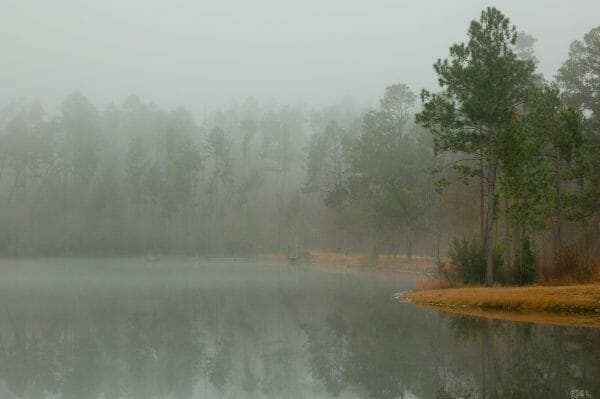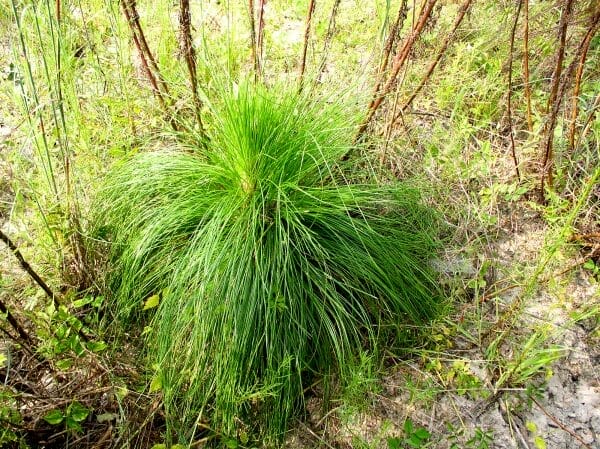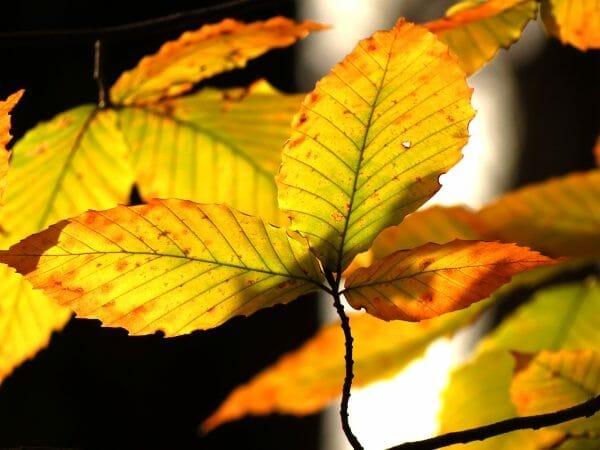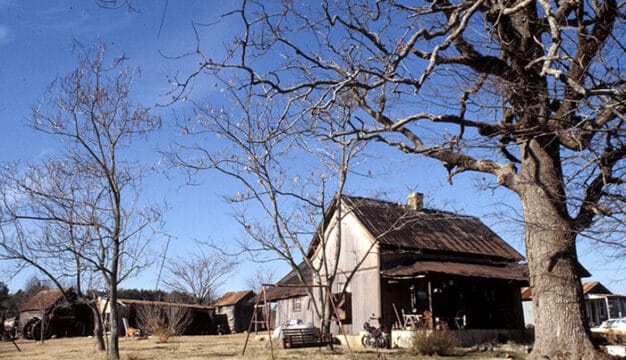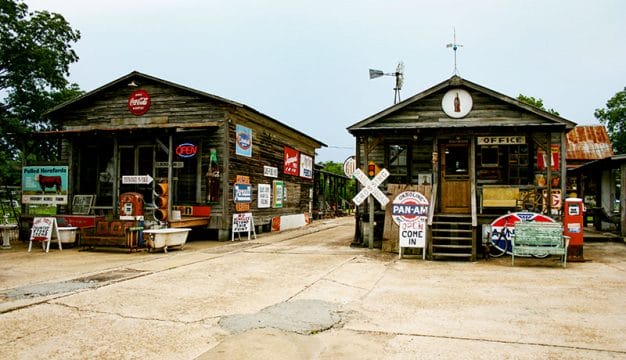Forest Regions of Alabama
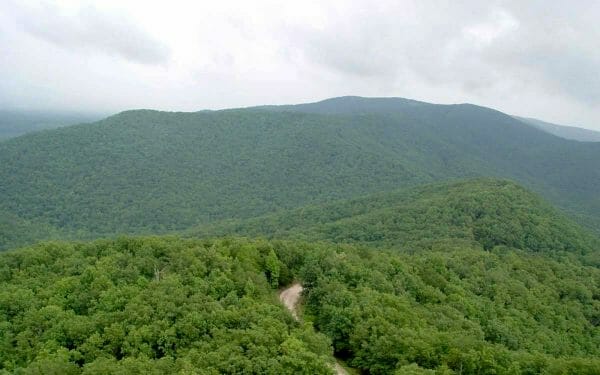 Mountain Longleaf National Wildlife Refuge
Alabama has always been a land under a forest. Alabama’s forests cover over 23 million acres, almost 70 percent of the state. These forests not only contribute to the state’s rich biodiversity, but they play an important economic role as well. In 2018, the forest products industry employed more than 36,000 Alabamians and generated sales of more than $12 billion in timber and related products.
Mountain Longleaf National Wildlife Refuge
Alabama has always been a land under a forest. Alabama’s forests cover over 23 million acres, almost 70 percent of the state. These forests not only contribute to the state’s rich biodiversity, but they play an important economic role as well. In 2018, the forest products industry employed more than 36,000 Alabamians and generated sales of more than $12 billion in timber and related products.
Historically, Alabama’s forests looked very different than today. Human settlement led to the clearing of forests for building materials and space for agriculture. As the population grew and settlements turned into modern cities, forest fragmentation increased. Modern forestry practices also caused change. Today, many acres managed for production are dominated by loblolly pine, a native but historically minor species that is prized for its quick growth and adaptability to high-intensity production.
 Controlled Burn
The exclusion of fire also dramatically changed Alabama’s forests. Fire shaped the plant communities of Alabama long before humans began to harness it for agriculture and then forestry. Where fire has been suppressed, those forests now include loblolly pine, water oak, and sweetgum. Longleaf pines, which were documented as covering most of the state, have been almost entirely excluded. While an average of 422,000 acres still burn annually across the state, fire is excluded in many areas. Despite all these changes, diverse forest regions still exist across the state. The current forests may not look exactly like they did centuries ago, but they still offer a breathtaking view of Alabama’s ecological abundance.
Controlled Burn
The exclusion of fire also dramatically changed Alabama’s forests. Fire shaped the plant communities of Alabama long before humans began to harness it for agriculture and then forestry. Where fire has been suppressed, those forests now include loblolly pine, water oak, and sweetgum. Longleaf pines, which were documented as covering most of the state, have been almost entirely excluded. While an average of 422,000 acres still burn annually across the state, fire is excluded in many areas. Despite all these changes, diverse forest regions still exist across the state. The current forests may not look exactly like they did centuries ago, but they still offer a breathtaking view of Alabama’s ecological abundance.
Alabama’s various forests generally align with the state’s physiographic regions, with some notable subregions. Historically, areas not fragmented by changing elevations or water were covered by longleaf pine and fire-adapted oaks including bluejack, blackjack, southern red, post, and scarlet. Where fires are permitted, these plant communities can still be found. In wetter areas and on steep slopes, other hardwood species are much more common. Species that flourish in wetter conditions, including black willow, river birch, hornbeam, elm, tulip poplar and sycamore, grow along streams and in forest bottoms. Steep slopes are typically dominated by oaks and hickories. Some species can only be found in certain regions and in very specific conditions. As one moves from Alabama’s northern border toward the coast, these changes highlight the unique and vital role of the state’s forests.
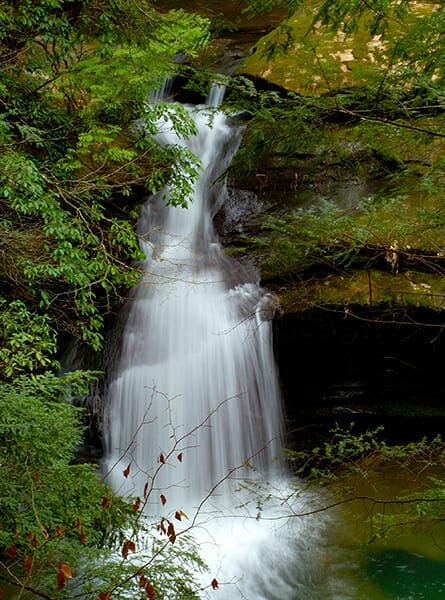 Caney Creek Falls in Bankhead National Forest
The Highland Rim is Alabama’s northernmost physiographic region. Its two differing forms of topography produce two distinct forest types in this region. Shortleaf pines and fire-adapted oaks are found in level areas with drier soils. As elevation changes dramatically, so do forest types. Forests surrounding the Tennessee River are oak-hickory, and steep slopes are primarily mixed hardwood. This is one of the few areas not shaped by fire in the state, as rocks and slopes naturally create a fragmented landscape that excluded fire. Other unique features of this forest include the few indigenous sugar maples, American smoketree, and honeylocust. This is also one of the few regions where longleaf pine and magnolia species have never been present in the natural forest.
Caney Creek Falls in Bankhead National Forest
The Highland Rim is Alabama’s northernmost physiographic region. Its two differing forms of topography produce two distinct forest types in this region. Shortleaf pines and fire-adapted oaks are found in level areas with drier soils. As elevation changes dramatically, so do forest types. Forests surrounding the Tennessee River are oak-hickory, and steep slopes are primarily mixed hardwood. This is one of the few areas not shaped by fire in the state, as rocks and slopes naturally create a fragmented landscape that excluded fire. Other unique features of this forest include the few indigenous sugar maples, American smoketree, and honeylocust. This is also one of the few regions where longleaf pine and magnolia species have never been present in the natural forest.
The Cumberland Plateau, which includes the area around Sand Mountain, is characterized more by rolling hills than the mountainous terrain of the Highland Rim. Its high elevation accounts for some hardwood species that are not found in southern parts of the state, including chestnut oak. Its forests are more continuous than the Highland Rim and are predominately shortleaf pine, longleaf pine, and fire-adapted oaks. On bluffs, cliffs, and ravines where fire could not spread easily, one can find a greater variety of tree species, although many of them survive in shallow soils as dense thickets of small, scrubby trees rather than grand forests. Virginia pine and black locust are two species that frequently colonize these rocky outcrops.
The Valley and Ridge region is the southwestern end of the Appalachian foothills, characterized by long ridges with valleys in between. It includes the state’s highest point, Mt. Cheaha, and many other peaks. In larger level areas below 1,900 feet in elevation, longleaf pine with pockets of shortleaf pine are common. Where fire has been maintained, these pine forests can still be found. Hardwoods are found in narrow valleys. This is almost the only location where sweet birch naturally occurs and is the northernmost reach of red bay.
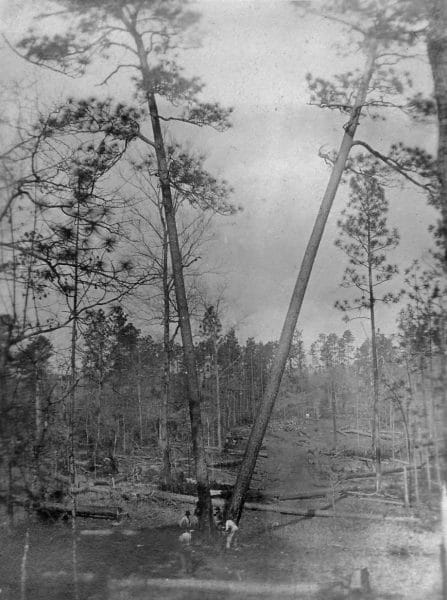 Felling Longleaf Pines
Moving further south, the Piedmont has mostly a shallow, sandy soil, which contributes to a high proportion of pines in this region. Fires were frequent, which maintained large longleaf forests with a lower proportion of shortleaf. Fire was less common in wet and rich northern slopes where hardwoods are the primary forest type. The richest soils in the area are located primarily in Chambers County, which also had the lowest proportion of longleaf relative to the rest of the region.
Felling Longleaf Pines
Moving further south, the Piedmont has mostly a shallow, sandy soil, which contributes to a high proportion of pines in this region. Fires were frequent, which maintained large longleaf forests with a lower proportion of shortleaf. Fire was less common in wet and rich northern slopes where hardwoods are the primary forest type. The richest soils in the area are located primarily in Chambers County, which also had the lowest proportion of longleaf relative to the rest of the region.
The Coastal Plain forest was historically predominately pine, and owing to replanting by the forest products industry, continues to be so today. With the exception of the Black Belt, the percentage of pines increases as one moves closer to the coastline. The Coastal Plain contains several notable subregions that are distinct in different ways. The Central Pine Belt is the northernmost portion of the Coastal Plain and represents the transition from the Piedmont forests to more dense pine forests on hilly topography. This area is noticeably different from other pine regions in the Coastal Plain because of its greater species diversity, including many oaks. Relative to the rest of the Coastal Plain, the Central Pine Belt has a lower percentage of pines, topping out around 45 percent.
The Black Belt is an anomaly in the state in that there were many prairies that were naturally treeless prior to widespread farming. Forests occurred on creek banks or on the poorest soils. Fires were infrequent, and as a result, most trees were hardwood species with very few pines.
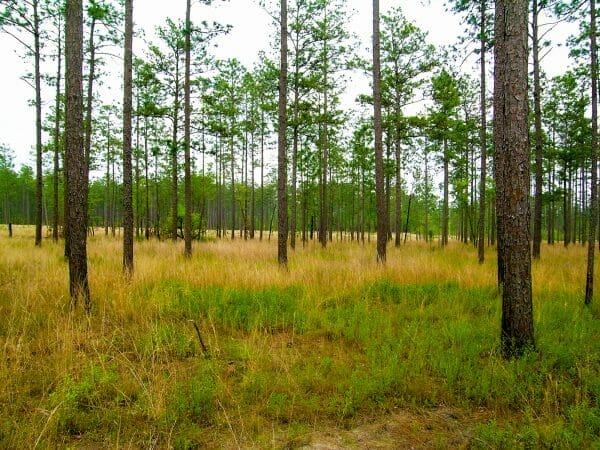 Conecuh National Forest
Another subregion of the Coastal Plain, the Southern Red Hills, is known for its “red levels,” or long-stretching hills of red sand that are wider than the valleys that sit between them. High rocky ridges exist in this range. The varied topography supports hardwood on higher ridges and vast longleaf forests in flat areas. Most of the longleaf have disappeared with the exclusion of fire, but they are beginning to make a comeback through conservation programs and reintroduction of fire. The slash pine reaches its northern limits here, and given the suitability of this area for growing all the southern pine species, it is still a prime location for timber production and wood processing.
Conecuh National Forest
Another subregion of the Coastal Plain, the Southern Red Hills, is known for its “red levels,” or long-stretching hills of red sand that are wider than the valleys that sit between them. High rocky ridges exist in this range. The varied topography supports hardwood on higher ridges and vast longleaf forests in flat areas. Most of the longleaf have disappeared with the exclusion of fire, but they are beginning to make a comeback through conservation programs and reintroduction of fire. The slash pine reaches its northern limits here, and given the suitability of this area for growing all the southern pine species, it is still a prime location for timber production and wood processing.
The Lime-Sink region is also commonly known as the Wiregrass for its abundant grass understory. Fire was frequent here and longleaf dominated the region until widespread timbering and agriculture began in the early nineteenth century. Cypress swamps and thickets are present in lower-lying areas. This area marks a distinct change in forests, with more than 75 percent of all trees being evergreen species, primarily pine. This is also the northernmost limit of the live oak.
The Southwestern Pine Hills were originally 85 percent pines. The forest products industry in Alabama began operations in this region for the production of naval stores and lumber. Despite the industry’s prevalence (and perhaps because of it through reforestation efforts), pine forests and cypress swamps have persisted. This area borders the coast, which has few grand trees but many scrubby slash pines, wax myrtle, and live oaks dotting the sand dunes.
From the foothills of Appalachia to the deltas of Mobile, Alabama’s forests boast amazing ecological diversity. They have remained a cornerstone of Alabama’s economy and culture despite centuries of major change. As our forests have evolved, so has our appreciation for them. Outdoor recreation like hunting, fishing, and hiking creates $7.5 billion dollars in revenue in the state each year: almost as much value as harvested trees. Flood control and drinking water protection are harder to quantify, but as the state continues to grow, this will undoubtedly become increasingly important. Alabama is one of the most forested states in the country, and with careful consideration for the value of this natural resource, these forests will remain a treasure for the state.
